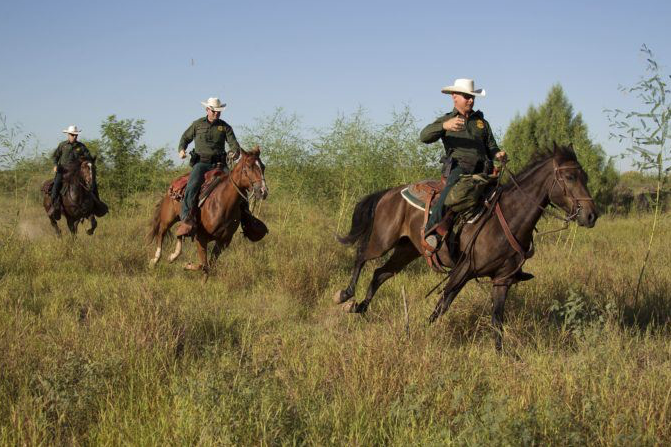CommentsIMMIGRATION WATCH - On the cover of Richard Slotkin’s classic study Gunfighter Nation’s 1998 edition is a painting depicting cowboys fighting Native Americans.
Up front a White cowboy rides his horse with rifle and reins in hand, his looped rope on the side, his gaze forward, his stance daring, heroic. The title of the painting is Under Attack.
The videos and photos from Texas that were released on September 19, 2021 also display an attack: U.S. Border Patrol Agents on horseback chasing, pushing, corralling Haitian migrants. An attack on dignity and humanity of those who are attempting to flee the humanitarian crisis they have been facing at their home country, only to be greeted by more violence where they arrive in the hopes of seeking asylum.
The image of a White patrol agent with a cowboy hat, on horseback grabbing a Black migrant, carries echoes of the American Old West, invoking the still lasting power and presence of the Myth of the Frontier. In Gunfighter Nation, cultural historian and scholar Slotkin explores how the Myth of the Frontier has always been inseparable from violence—a violence that was carried out in the name of progress and civilization, while at the same time justifying conquests, imperial ambitions, and endless tyranny. “The images and video from Del Rio of predominantly White federal agents on horses wielding long reins and chasing Black migrants recall the often unexamined and disturbing US history of racial and ethnic violence, including by border patrols, slave patrols, and vigilantes,” states Human Rights Watch, commenting on the explicit history of systematic racism in U.S. immigration enforcement.
Is this what we call “homeland security”? Or is it, to borrow from Slotkin, a “savage war” fought this time not on the Western plains, but instead the Southern border of the nation-state? Is this how the “Cowboys and Indians” games continue today? Where does national security and patriotic virtue end and brazen cruelty and immorality begin?
In regard to the treatment of the Haitian migrants at the U.S.-Mexico border, White House press secretary, Jen Psaki, shared that President Mr. Biden believes that the footage and photos are “horrific” yet “they don’t represent who we are as a country.” Following the January 6th attack on the Capitol Hill, Biden had also said, “Let me be very clear — the scenes of chaos at the Capitol do not reflect a true America, do not represent who we are.”
Such statements regarding accurate representation of “true America” are deeply problematic. They create a deceptive dichotomy: a false America versus a true America. There is no such division; it is all America. White nationalists scaling the walls of the Capitol are America. Border Patrol Agents on horseback chasing migrants are America. Immigrants and refugees from across the world who have come to the United States for a better, safer life, are also America—the British, Irish, Italian, Russian, Greek, Chinese, Japanese, Filipino, Vietnamese, Nigerian, Somali, Sudanese, Kenyan, Jamaican, Mexican, El Salvadorian, Columbian, Indian, Arab, and more. So are nativist ideologies, vigilante politics, the privately owned and run detention centers…all of it is America.
It is crucial to accept this complexity. Because complexity, diversity, inner contradictions are not the threat to the so-called “United” States of America. The denial of the fractures, inherent tensions, and violence is the real danger. The splitting. The projection. The refusal of responsibility. To state repeatedly that the “horrific” or “chaotic” scenes do not represent America is a barrier to accountability. Because only after we own the pain, the shame, only after we reckon with the difficult truths of our history and today, can we proceed with humility and wisdom that is necessary for cultural healing and political transformation.
In Gunfighter Nation, Slotkin explains, “The moral landscape of the Frontier Myth is divided by significant borders,” as in “wilderness/civilization” and “Indian/White.” Affirming the enduring hold of this simplistic and polarizing worldview has on the American consciousness, he remarks, “Even in its liberal form, the traditional Myth of the Frontier was exclusionist in its premises, idealizing the White male adventurer as the hero of national history.” “Historical memory will have to be revised,” writes Slotkin, “not to invent an imaginary role for supposedly marginal minorities, but to register the fact that our history in the West and in the East, was shaped from the beginning by the meeting, conversation, and mutual adaptation of different cultures.”
What we witness at Del Rio offers yet another opportunity for this revision, and to see that the image of the White male adventurer high on his horse is not so much about bravery but tyranny and, ultimately, violence over one that he deems inferior.
Our response can no longer remain confined to the fear of negative cultural representation and denial. Every time migrants and refugees are under attack, human rights are under attack. Every time human rights are under attack, so is our morality as a nation, our humanity.
Ipek S. Burnett is a depth psychologist and Turkish novelist living in San Francisco. She’s the author of A Jungian Inquiry into the American Psyche: The Violence of Innocence (Routledge, 2019). For more information visit: www.ipekburnett.com.






